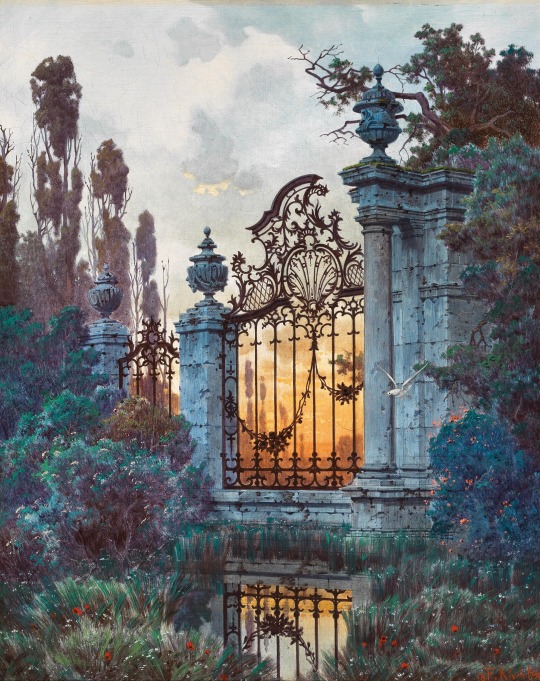Photo

Hathor chapel at the temple of Thutmose III. in Deir el-Bahari, photo from excavation by Henri Édouard Naville (1907).
3K notes
·
View notes
Text
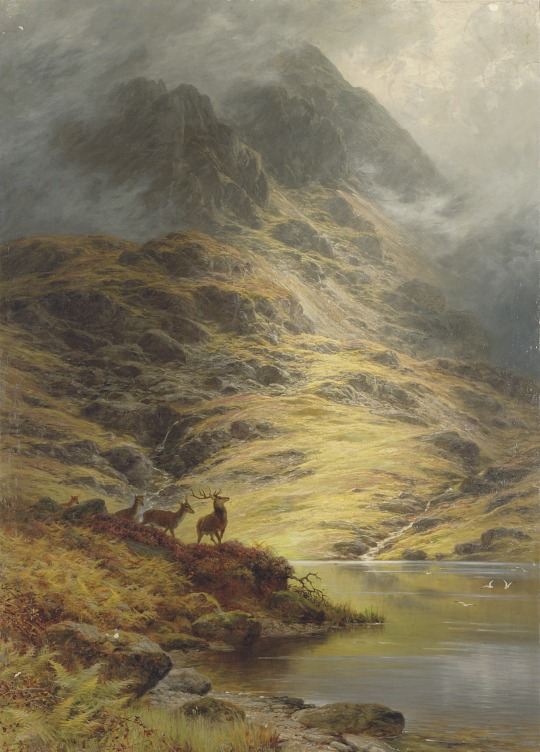
The Incoming Mist, Deer in the Highlands by Charles Stuart
1K notes
·
View notes
Text
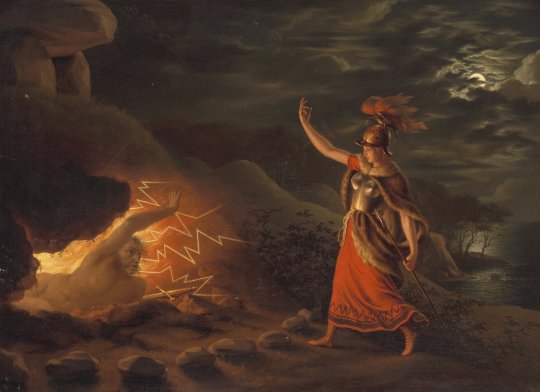
Hervör retrieves the sword from Angantýr by Christian Gottlieb Kratzenstein Stub
Hervör awakens her father Angantýr's ghost from his barrow on Samsø to demand the cursed magic sword Tyrfing
55 notes
·
View notes
Text

Mary Magdalene in the Desert by Pierre Puvis de Chavannes (1824 - 1898)
333 notes
·
View notes
Photo
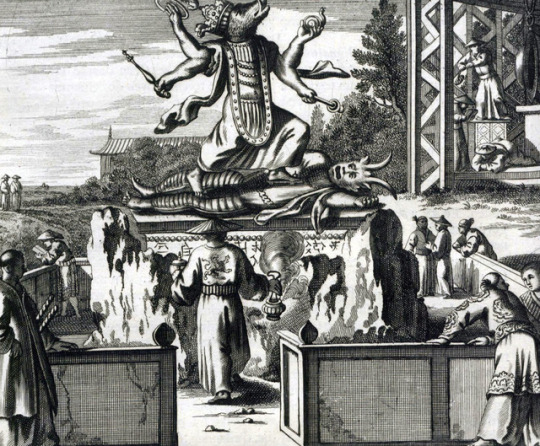
Arnoldus Montanus - Gedenkwaerdige gesantschappen der Oost-Indische Maetschappy in’t Vereenigde Nederland (1669).
43 notes
·
View notes
Text
"Ein Sof, or Eyn Sof (/eɪn sɒf/, Hebrew: אין סוף), in Kabbalah, is understood as God prior to any self-manifestation in the production of any spiritual realm, probably derived from Solomon ibn Gabirol's (c. 1021 – c. 1070) term, "the Endless One" (she-en lo tiklah). Ein Sof may be translated as "unending", "(there is) no end", or infinity.[1] It was first used by Azriel (c. 1160 – c. 1238), who, sharing the Neoplatonic belief that God can have no desire, thought, word, or action, emphasized by it the negation of any attribute. Of the Ein Sof, nothing ("Ein") can be grasped ("Sof"-limitation). It is the origin of the Ohr Ein Sof, the "Infinite Light" of paradoxical divine self-knowledge, nullified within the Ein Sof prior to creation. In Lurianic Kabbalah, the first act of creation, the Tzimtzum self "withdrawal" of God to create an "empty space", takes place from there. In Hasidic Judaism, the Tzimtzum is only the illusionary concealment of the Ohr Ein Sof, giving rise to monistic panentheism. Consequently, Hasidism focuses on the Atzmus divine essence, rooted higher within the Godhead than the Ein Sof, which is limited to infinitude, and reflected in the essence (etzem) of the Torah and the soul."

1 note
·
View note
Text
In normal terms, the opposite of a yogi is a bhogi, a pleasure seeker. It is Shaivism’s claim that it offers both yoga and bhoga, both spiritual freedom and enjoyment of the world. No wonder then, that the great Shaivite master Abhinavagupta is also the principle articulator of the rasa theory of art. It is a truly Shaivite approach to accept all emotions, both negative and positive, as part of the fabric of life and to enjoy their interplay, not seeking to eliminate any of them, while remaining anchored in higher Consciousness. If the yogi is Shiva seeking purity and control, the artist is Shakti, tolerant as a mother, cherishing even the apparently negative aspects of life.
Shankarananda

4 notes
·
View notes
Text
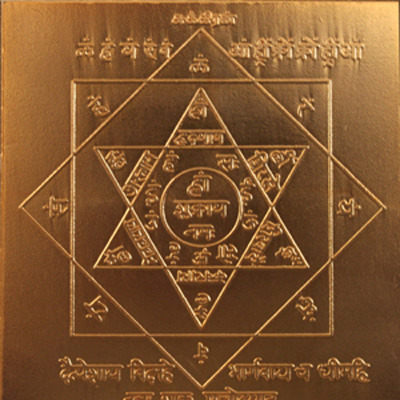
Image: Shukra (Venus) Yantra
"Malavya Yoga is formed by the exceptional strength of Venus. This yoga is formed when Venus is either in your 1st (ascendant), 4th, 7th or 10th house and is in great strength, i.e., it is in its own house of Taurus or Libra or in its exaltation sign of Pisces.
Malavya Yoga in your horoscope makes you very attractive and charming. It also blesses you with comforts in life, prosperity and popularity. This yoga is also known as a Maha Purush (Exceptional Human Being) Yoga and is found in the birth chart of only a few fortunate people! A yoga, as you might already know, is Vedic Astrology’s unique method of calculating some stellar positions and combinations of planets where the Sum of the effect of those planets is more than the Parts that add up to form the Yoga.
A yoga confers some unique and powerful results, whether they are beneficial or maleficent, depending on the horoscope of the person where the yoga resides.There are only 5 powerful planetary combinations acknowledged in Vedic Scriptures which create Maha Purush Yoga that makes one stand apart from the crowd and very distinguished. Malavya Yoga is one of them."
1 note
·
View note
Text
ABHINAVAGUPTA
"Abhinavagupta (c. 950 – 1016 AD) was a philosopher, mystic and aesthetician from Kashmir. He was also considered an influential musician, poet, dramatist, exegete, theologian, and logician – a polymathic personality who exercised strong influences on Indian culture.

He was born in Kashmir in a family of scholars and mystics and studied all the schools of philosophy and art of his time under the guidance of as many as fifteen (or more) teachers and gurus. In his long life he completed over 35 works, the largest and most famous of which is Tantrāloka, an encyclopaedic treatise on all the philosophical and practical aspects of Kaula and Trika (known today as Kashmir Shaivism). Another one of his very important contributions was in the field of philosophy of aesthetics with his famous Abhinavabhāratī commentary of Nāṭyaśāstra of Bharata Muni.
Life
"Abhinavagupta" was not his real name, rather a title he earned from his master, carrying a meaning of "competence and authoritativeness". In his analysis, Jayaratha (1150–1200 AD) – who was Abhinavagupta's most important commentator – also reveals three more meanings: "being ever vigilant", "being present everywhere" and "protected by praises".Raniero Gnoli, the only Sanskrit scholar who completed a translation of Tantrāloka in a European language, mentions that "Abhinava" also means "new", as a reference to the ever-new creative force of his mystical experience.
From Jayaratha, we learn that Abhinavagupta was in possession of all the six qualities required for the recipients of the tremendous level of śaktipāta, as described in the sacred texts (Śrīpūrvaśāstra):] an unflinching faith in God, realisation of mantras, control over objective principles (referring to the 36 tattvas), successful conclusion of all the activities undertaken, poetic creativity and spontaneous knowledge of all disciplines.
Abhinavagupta's creation is well equilibrated between the branches of the triad (Trika): will (icchā), knowledge (jñāna), action (kriyā); his works also include devotional songs, academical/philosophical works and works describing ritual/yogic practices.
As an author, he is considered a systematiser of the philosophical thought. He reconstructed, rationalised and orchestrated the philosophical knowledge into a more coherent form, assessing all the available sources of his time, not unlike a modern scientific researcher of Indology.
Various contemporary scholars have characterised Abhinavagupta as a "brilliant scholar and saint","the pinnacle of the development of Kasmir Śaivism"] and "in possession of yogic realization".
Social background, family and disciples
"Magical" birth
The term by which Abhinavagupta himself defines his origin is "yoginībhū", 'born of a yoginī'. In Kashmir Shaivism and especially in Kaula it is considered that a progeny of parents "established in the divine essence of Bhairava", is endowed with exceptional spiritual and intellectual prowess. Such a child is supposed to be "the depository of knowledge", who "even as a child in the womb, has the form of Shiva", to enumerate but a few of the classical attributes of his kind.
Parents
His mother, Vimalā (Vimalakalā) died when Abhinavagupta was just two years old; as a consequence of losing his mother, of whom he was reportedly very attached, he grew more distant from worldly life and focused all the more on spiritual endeavour.
The father, Narasiṃha Gupta, after his wife's death favoured an ascetic lifestyle, while raising his three children. He had a cultivated mind and a heart "outstandingly adorned with devotion to Mahesvara (Shiva)" (in Abhinavagupta's own words). He was Abhinavagupta's first teacher, instructing him in grammar, logic and literature.
Family
Abhinavagupta had a brother and a sister. The brother, Manoratha, was a well-versed devotee of Shiva. His sister, Ambā (probable name, according to Navjivan Rastogi), devoted herself to worship after the death of her husband in late life.
His cousin Karṇa demonstrated even from his youth that he grasped the essence of Śaivism and was detached of the world. His wife was presumably Abhinavagupta's older sister Ambā, who looked with reverence upon her illustrious brother. Ambā and Karṇa had a son, Yogeśvaridatta, who was precociously talented in yoga](yogeśvar implies "lord of yoga").
Abhinavagupta also mentions his disciple Rāmadeva as faithfully devoted to scriptural study and serving his master. Another cousin was Kṣema, possibly the same as Abhinavagupta's illustrious disciple Kṣemarāja. Mandra, a childhood friend of Karṇa, was their host in a suburban residence; he was not only rich and in possession of a pleasing personality, but also equally learned. And last but not least, Vatasikā, Mandra's aunt, who got a special mention from Abhinavagupta for caring for him with exceptional dedication and concern; to express his gratitude, Abhinavagupta declared that Vatasikā deserved the credit for the successful completion of his work.
The emerging picture here is that Abhinavagupta lived in a nurturing and protected environment, where his creative energies got all the support they required. Everyone around him was filled with spiritual fervor and had taken Abhinavagupta as their spiritual master. Such a supporting group of family and friends was equally necessary as his personal qualities of genius, to complete a work of the magnitude of Tantrāloka.
Ancestors
By Abhinavagupta's own account, his most remote known ancestor was called Atrigupta, born in Madhyadeśa: [Manusmirti (circa 1500 BC, 2/21) defines the Madhyadesh region as vast plains between Himalaya and Vindhya mountains and to the east of the river Vinasana (invisible Saraswati) and to the west of Praya]. Born in Madhyadeśa he travelled to Kashmir at the request of the king Lalitāditya, around year 740 CE
Masters
Abhinavagupta is famous for his voracious thirst for knowledge. To study he took many teachers (as many as 15), both mystical philosophers and scholars. He approached Vaiṣṇavas, Buddhists, Śiddhānta Śaivists and the Trika scholars.
Among the most prominent of his teachers, he enumerates four. Vāmanātha who instructed him in dualistic Śaivism and Bhūtirāja in the dualist/nondualist school. Besides being the teacher of the famous Abhinavagupta, Bhūtirāja was also the father of two eminent scholars.
Lakṣmaṇagupta, a direct disciple of Utpaladeva, in the lineage of Trayambaka, was highly respected by Abhinavagupta and taught him all the schools of monistic thought : Krama, Trika and Pratyabhijña (except Kula).
Śambhunātha taught him the fourth school (Ardha-trayambaka). This school is in fact Kaula, and it was emanated from Trayambaka's daughter.
For Abhinavagupta, Śambhunātha was the most admired guru. Describing the greatness of his master, he compared Śambhunātha with the Sun, in his power to dispel ignorance from the heart, and, in another place, with "the Moon shining over the ocean of Trika knowledge".
Abhinavagupta received Kaula initiation through Śambhunāthas wife (acting as a dūtī or conduit). The energy of this initiation is transmitted and sublimated into the heart and finally into
consciousness. Such a method is difficult but very rapid and is reserved for those who shed their mental limitations and are pure.
It was Śambhunātha who requested of him to write Tantrāloka. As guru, he had a profound influence in the structure of Tantrāloka and in the life of its creator, Abhinavagupta.
As many as twelve more of his principal teachers are enumerated by name but without details. It is believed that Abhinavagupta had more secondary teachers. Moreover, during his life he had accumulated a large number of texts from which he quoted in his magnum opus, in his desire to create a synthetic, all-inclusive system, where the contrasts of different scriptures could be resolved by integration into a superior perspective.
Lifestyle
Abhinavagupta remained unmarried all his life, and as an adept of Kaula, at least initially maintained brahmacharya and supposedly used the vital force of his energy (ojas) to deepen his understanding of the spiritual nervous system he outlined in his works—a system involving ritual union between Purusha as (Shiva) and Shakti. Such union is essentially non-physical and universal, and thus Abhinavagupta conceived himself as always in communion with Shiva-Shakti. In the context of his life and teachings, Abhinavagupta parallels Shiva as both ascetic and enjoyer.
He studied assiduously at least until the age of 30 or 35, To accomplish that he travelled, mostly inside Kashmir. By his own testimony, he had attained spiritual liberation through his Kaula practice, under the guidance of his most admired master, Śambhunātha.
He lived in his home (functioning as an ashram) with his family members and disciples, and he did not become a wandering monk, nor did he take on the regular duties of his family, but lived out his life as a writer and a teacher. His personality was described as a living realisation of his vision.
In an epoch pen-painting he is depicted seated in Virasana, surrounded by devoted disciples and family, performing a kind of trance-inducing music at veena while dictating verses of Tantrāloka to one of his attendees – behind him two dūtī (women yogi) waiting on him. A legend about the moment of his death (placed somewhere between 1015 and 1025, depending on the source), says that he took with him 1,200 disciples and marched off to a cave (the Bhairava Cave, an actual place known to this day), reciting his poem Bhairava-stava, a devotional work. They were never to be seen again, supposedly translating together into the spiritual world.
Works
Abhinavagupta's works fall into multiple sections: manuals of religious ritual, devotional songs, philosophical works and philosophy of aesthetics. Here are enumerated most of his works.
Religious works
Tantraloka
His most important work was Tantrāloka,(translates into "To Throw Light on Tantra"), a synthesis of all the Trika system. Its only complete translation in a European language – Italian – is credited to Raniero Gnoli, now at its second edition. The esoteric chapter 29 on the Kaula ritual was translated in English together with Jayaratha's commentary by John R. Dupuche, Rev. Dr. A complex study on the context, authors, contents and references of Tantrāloka was published by Navjivan Rastogi, Prof. of the Lucknow University. Though there are no English translations of Tantrāloka to date, the last recognized master of the oral tradition of Kashmir Shaivism, Swami Lakshman Joo, gave a condensed version of the important philosophical chapters of ‘‘Tantrāloka’‘ in his book, Kashmir Shaivism – The Secret Supreme.
Another important text was the commentary on Parātrīśikā, Parātrīśikāvivaraṇa, detailing the signification of the phonematic energies and their two sequential ordering systems, Mātṛkā and Mālinī. This was the last great translation project of Jaideva Singh.
Tantrasara
Tantrasara
Tantrasāra ("Essence of Tantra") is a summarised version, in prose, of Tantrāloka, which was once more summarised in Tantroccaya, and finally presented in a very short summary form under the name of Tantravaṭadhānikā – the "Seed of Tantra".
Pūrvapañcikā was a commentary of Pūrvatantra, alias Mālinīvijaya Tantra, lost to this day. Mālinīvijayā-varttika("Commentary on Mālinīvijaya") is a versified commentary on Mālinīvijaya Tantra's first verse. Kramakeli, "Krama's Play" was a commentary of Kramastotra, now lost. Bhagavadgītārtha-saṃgraha which translates "Commentary on Bhagavad Gita" has now an English translation by Boris Marjanovic.]
Other religious works are: Parātrīśikā-laghuvṛtti, "A Short Commentary on Parātrīśikā", Paryantapañcāśīkā ("Fifty Verses on the Ultimate Reality"), Rahasyapañcadaśikā ("Fifteen Verses on the Mystical Doctrine"), Laghvī prakriyā ("Short Ceremony"), Devīstotravivaraṇa ("Commentary on the Hymn to Devi") and Paramārthasāra ("Essence of the Supreme Reality").
Devotional hymns
Abhinavagupta has composed a number of devotional poems, most of which have been translated into French by Lilian Silburn:
• Bodhapañcadaśikā – "Fifteen Verses on Consciousness";
• Paramārthacarcā – "Discussion on the Supreme Reality";
• Anubhavanivedana – "Tribute of the Inner Experience";
• Anuttarāṣṭikā – "Eight Verses on Anuttara";
• Krama-stotra – an hymn, different from the fundamental text of the Krama school;
• Bhairava-stava – "Hymn to Bhairava";
• Dehasthadevatācakra-stotra – "Hymn to the Wheel of Divinities that Live in the Body";
• Paramārthadvādaśikā – "Twelve Verses on the Supreme Reality" and
• Mahopadeśa-viṃśatikā – "Twenty Verses on the Great Teaching".
• Another poem Śivaśaktyavinābhāva-stotra – "Hymn on the Inseparability of Shiva and Shakti" was lost.
Philosophical works
One of the most important works of Abhinavagupta is Īśvarapratyabhijñā-vimarśini ("Commentary to the Verses on the Recognition of the Lord") and Īśvarapratyabhijñā-vivṛti-vimarśini ("Commentary on the explanation of Īśvarapratyabhijñā"). This treatise is fundamental in the transmission of the Pratyabhijña school (the branch of Kashmir Shaivism based on direct recognition of the Lord) to our days. Another commentary on a Pratyabhijña work – Śivadṛṣtyā-locana ("Light on Śivadṛṣṭi") – is now lost. Another lost commentary is Padārthapraveśa-nirṇaya-ṭīkā and Prakīrṇkavivaraṇa ("Comment on the Notebook") referring to the third chapter of Vākyapadīya of Bhartrihari. Two more philosophical texts of Abhinavagupta are Kathāmukha-tilaka("Ornament of the Face of Discourses") and Bhedavāda-vidāraṇa ("Confrontation of the Dualist Thesis"). Abhinavagupta's thought was strongly influenced by Buddhist logic.
Poetical and dramatic works
Abhinavabharati
Abhinavaguptas most important work on the philosophy of art is Abhinavabhāratī – a long and complex commentary on Natya Shastra of Bharata Muni. This work has been one of the most important factors contributing to Abhinavagupta's fame up until present day. His most important contribution was that to the theory of rasa(aesthetic savour).
Other poetical works include: Ghaṭa-karpara-kulaka-vivṛti, a commentary on "Ghaṭakarpara" of Kalidasa; Kāvyakauṭukavivaraṇa, a "Commentary to the Wonder of Poetry" (a work of Bhaṭṭa Tauta), now lost; and Dhvanyālokalocana, "Illustration of Dhvanyāloka", which is a famous work of Anandavardhana."
0 notes
